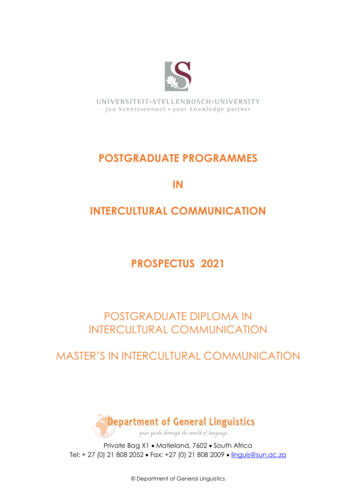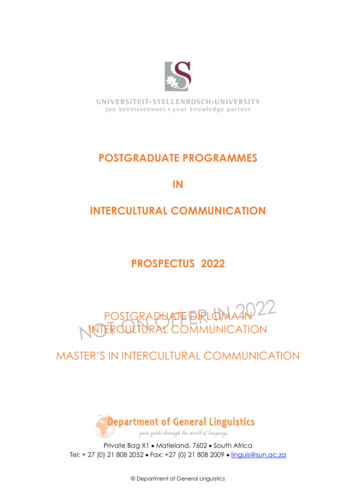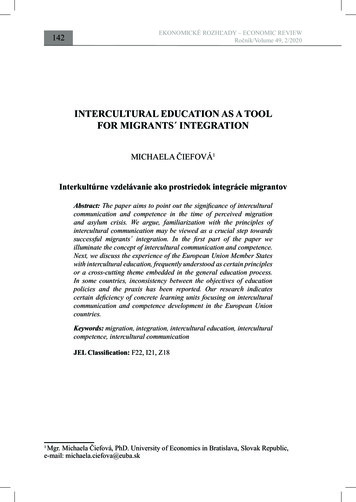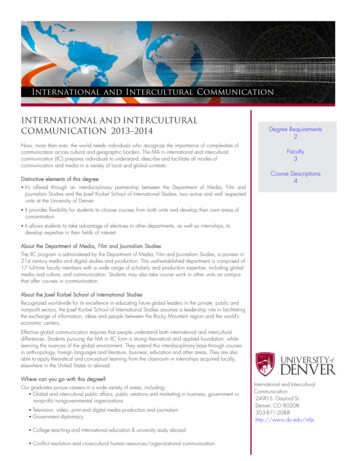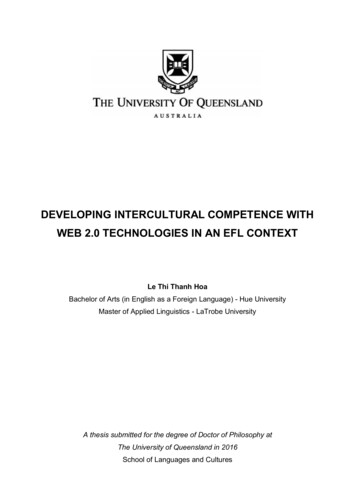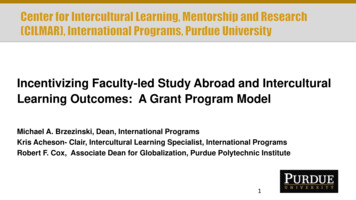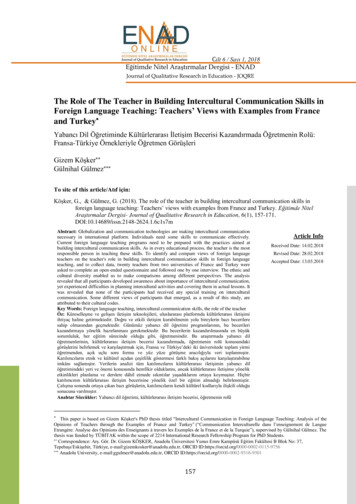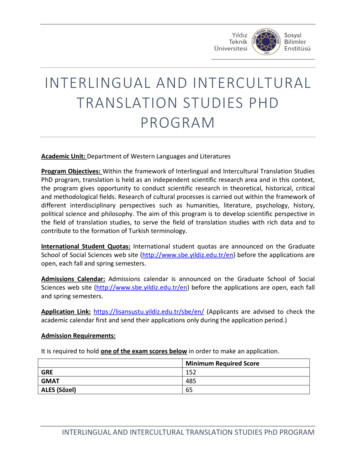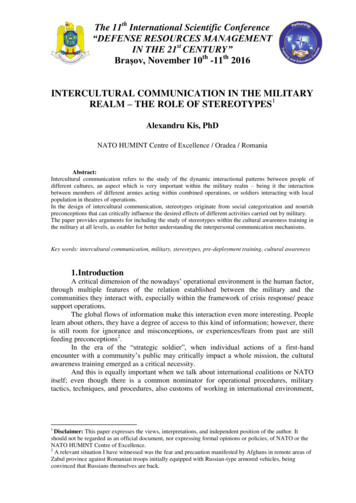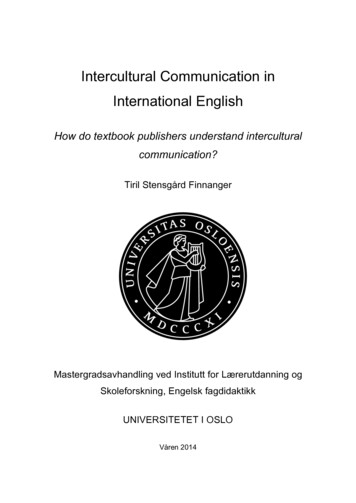
Transcription
Intercultural Communication inInternational EnglishHow do textbook publishers understand interculturalcommunication?Tiril Stensgård FinnangerMastergradsavhandling ved Institutt for Lærerutdanning ogSkoleforskning, Engelsk fagdidaktikkUNIVERSITETET I OSLOVåren 2014
II
III
Tiril Stensgård Finnanger2014Intercultural Communication in International English: How do textbook publishersunderstand intercultural communication?Tiril Stensgård Finnangerhttp://www.duo.uio.noTrykk: Reprosentralen, Universitetet i OsloIV
Intercultural Communication inInternational English: How do textbookpublishers understand interculturalcommunication?V
AbstractThe present thesis studies textbook publishers’ understanding of intercultural communication.The study has taken the competence aim “reflect on how cultural differences and dissimilarvalue systems can affect communication”, which is taken from the subject curriculum in theprogramme subject International English, as a starting point for analysis. The thesis is acontent analysis of four textbooks designed for International English. In addition toinvestigating textbook publishers’ understanding of intercultural communication, the studyseeks to find out whether or not there has been a washback effect from the writtenexaminations in the new editions of the textbooks, which were published in 2012. The thesisalso discusses how and to what extent the textbooks can facilitate greater interculturalcompetence.The findings indicate that the publishers’ understanding of interculturalcommunication is broad, but that it is mainly concerned with communication between peoplewith different national or ethnic backgrounds. We see this most clearly in the literary texts.The analysis of the tasks shows that the publishers suggest many approaches to thedevelopment of intercultural communication, but there is a large majority of textcomprehension tasks.There is clear evidence of washback in the new editions of the textbooks. Thefindings indicate that there is now a larger focus on intercultural communication ininternational education and employment opportunities, and less focus on interculturalcompetence when traveling for leisure.The study also discusses the extent to which the textbooks can facilitate greaterintercultural competence. The findings show that the textbooks can move the studentstowards the right attitudes, provide knowledge, and develop the necessary skills, but thestudents also have to be motivated enough to make an effort on their own.VI
SammendragDenne mastergradsavhandlingen undersøker lærebokforlags forståelse av interkulturellkommunikasjon. Avhandlingen tar utgangspunkt i kompetansemålet ”reflektere over hvordankulturforskjeller og ulike verdisystem kan påvirke kommunikasjon”, som er tatt fralæreplanen i programfaget Internasjonal Engelsk. Studien er utformet som eninnholdsananlyse av fire lærebøker for dette faget. Studien ønsker også å finne ut av om deskriftlige eksamensoppgavene som er gitt i faget kan ha påvirket de nye utgavene av bøkenesom kom ut i 2012. I tillegg drøfter avhandlingen om og i hvilken grad lærebøkene kan leggetil rette for utvikling av interkulturell kompetanse hos eleven.Funnene viser at forlagenes forståelse av interkulturell kommunikasjon er bred, menat det i hovedsak dreier seg om kommunikasjon mellom personer av ulik nasjonal eller etniskopprinnelse. Dette er spesielt godt synlig i de skjønnlitterære tekstene.Når det kommer til oppgaver, viser funnene at forlagene legger opp til variertetilnærminger til utvikling av interkulturell kompetanse, men at det er stor overvekt avtekstforståelsesoppgaver.Det er tydelig at forlagene har blitt påvirket av de skriftlige eksamensoppgavene somer gitt i faget. Funnene viser at det er blitt mer fokus på interkulturell kommunikasjon itekstene som omhandler studie- og arbeidsmuligheter i utlandet og mindre fokus påinterkulturell kompetanse under ferieopphold i andre land.Studien drøfter også i hvilken grad lærebøkene legger til rette for utvikling avinterkulturell kompetanse og drøftingen viser at lærebøkene i stor grad kan bidra til å giriktige holdninger, mer kunnskap og bedre ferdigheter, men at elevene også er nødt til å væremotiverte og gjøre en innsats på egenhånd.VII
AcknowledgementsFirst, I would like to express my sincerest gratitude to my thesis supervisor, Philip Grey,PhD. Your guidance has been invaluable throughout this process. I am truly grateful for thefeedback that you have given me.I would also like to show my appreciation to Associate Professor at the University ofOslo, Glenn Ole Hellekjær, for taking time to answer any question that I have had during thelast year.I would like to thank the publishers Cappelen Damm and H. Aschehoug & Co. forproviding me with the textbooks that I needed for this study. In addition, I would like tothank the library at Drømtorp videregående skole for letting me borrow one of their textbooksfor a whole year.A special thanks to my wonderful parents, Bjørn and Wenche, for your eternal loveand support in all of my endeavors.Finally, the biggest thanks of all go to Bjørn Gunnar. Your love and patience meansmore than you can possibly imagine.Oslo, May 2014Tiril Stensgård FinnangerVIII
Table of content1Introduction. 11.1TheKnowledgePromotion . 11.1.1InternationalEnglish. 21.1.2Thecompetenceaim . 51.2Purposeofthisstudy. 51.3Relevantresearch . 71.4Researchstatement . 81.5Outlineofthethesis. 91.6KeyTerms .102Theory. 112.1Whatisculture? .112.2Whatiscommunication? .132.3Culture’simpactoncommunication lcommunicationineducation proachestointerculturalcommunication ��emic”and”etic”approach .232.6.3Theexperientiallearningapproach 62.7.1Positiveandnegativewashback .282.7.2Washbackintextbooks .282.8Summaryofchapter .293Methodology . alapproach .333.2.1Contentanalysis .333.2.2Reliability .333.2.3Validity .343.3Literarytextandfactualnon- introductorytexts .353.4Factualintroductiontexts .363.5Tasks.363.5.1Selectionoftasks .373.5.2Classificationoftasks.383.5.3Categories inations .423.8Summaryofchapter .424Primarysources . 434.1Presentationoftextbooks .434.1.1Access2007 .434.1.2Access2012 .43IX
4.1.3Worldwide2007.444.1.4Worldwide2012.444.2Texts xtsandfactualnon- ations.564.4.1Workingorvolunteeringabroad ty .574.4.4Textorfilmfromthecourse .584.4.5Norwegianculture.584.5Summaryofchapter .595Analysisofprimarysources . 1.1Business .605.1.2Volunteerabroad .625.1.3Educationandemploymentabroad .635.1.4AConciseChinese- EnglishDictionaryforLovers .645.2Theoreticalanalysisoftextsandtasks icalityapproach essapproach.685.2.4TheAll- ‐AmericanSlurp–Anexperientiallearningapproach .705.2.5Miscellaneoustasks .725.3Finalremarks .755.4Summaryofchapter .766Discussion. 776.1Researchstatement erstandingofinterculturalcommunication? dfactualnon- ‐introductorytexts withthetexts? Lund(2006) .896.7Summaryofchapter .917Conclusion . 937.1Implicationsoffindings .937.2Suggestionsforfurtherresearch .947.3Finalremarks .95Listofreferences. 97Thetextbooks.97References .97Appendices. 101Appendix1- Listofliterarytextsandfactualnon- introductorytextsinappropriatecategories. 101Appendix2–TasksinAccess2007. 103X
Appendix3–TasksinAccess2012. 104Appendix4–TasksinWorldwide2007 . 105Appendix5–TasksinWorldwide2012 . 106XI
List of tables and interculturalcompetence . 19Table4.1:Numberoftextsineachgenre . 50Table4.2:Numberoftasksineachcategory. 07 . 103TableA.2:TasksinotherchaptersinAccess2007 . 012 . 104TableA.4:TasksinotherchaptersinAccess2012 . 2007 . 105TableA.6:TasksinotherchaptersinWorldwide2007. 2012 . 106TableA.8:TasksinotherchaptersinWorldwide2012. 106XII
XIII
XIV
1 IntroductionIn 2007/2008, I took the then brand new course International English as one of myprogramme subjects at upper secondary school. Since my class was the first to be taughtunder the new national curriculum The Knowledge Promotion (Kunnskapsløftet), this was thefirst time International English was taught. I did not really know what to expect from thecourse. No one had ever taken the course before, and no teacher had ever taught the coursebefore, so there was really no one who could share their experiences of the subject with me.However, the name of the course, International English, gave me some expectations. I hopedthat we would learn about people in far-away places and about cultures that are vastlydifferent from my own. During the first lesson, browsing through my brand new textbook,looking at the pictures and skimming through the headlines, I was excited. My teacher saidthat the focus of this course was not Britain and America, as had been the focus of myEnglish tuition so far. In this course, we were going to learn about how English is used allover the world.A year later, I had worked on many exciting topics, I had improved my English skills,and I had traveled to Cambridge with the rest of my class. We had learned about differenttypes of English accents, we had done an in-depth project on global challenges and we hadused international media to find up-to-date information. But still, I was a little disappointed inthe course. Despite its name, the course had not felt very international.It was not until I took the English didactics course at the University of Oslo that Irealized what I had been missing in International English. In this course, I was introduced tothe concept of intercultural communication. I realized that what was lacking from theInternational English course when I took it, was interaction with other people from otherparts of the world who were in the same situation as me. We had not been presented withother people who used English as a foreign language, and we had not been told thatcommunication is so much more than exchanging words. In the International English course,we had worked with topics, but not so much with people, and I believe that it is the peoplewho make the topics international.1.1 The Knowledge PromotionThe Knowledge Promotion Reform was introduced in the fall of 2006. It is a comprehensivecurriculum reform that covers primary, lower secondary, and upper secondary education and1
training in Norway. The Knowledge Promotion Reform consists of the Core Curriculum andthe Quality Framework (Generell del av læreplanen), the subject curricula (læreplaner),distribution of teaching hours in each subject, and plans for individual assessment. In thesubject curricula, the five basic skills are integrated and adapted to each subject. The basicskills are the ability to express oneself orally, the ability to express oneself in writing, theability to read, numeracy, and the ability to use digital tools (Utdanningsdirektoratet, 2007).Throughout the curriculum in the compulsory English course1, intercultural awarenessis important. In the Purpose section of the subject curriculum, we find that “when using thelanguage for communication, we must [ ] be able to take cultural norms and conventionsinto consideration” because “[d]evelopment of communicative language skills and culturalinsight can promote greater interaction, understanding and respect between persons withdifferent cultural backgrounds” (Utdanningsdirektoratet, 2013). The policy makers obviouslythink that intercultural awareness is important in English language teaching. However, thereare hardly any competence aims for any of these 11 school years that specifically promoteintercultural awareness. In the in the curriculum for years 3 and 4, we find the competenceaim “converse about some aspects of different ways of living, traditions and customs inEnglish-speaking countries and in Norway” (Utdanningsdirektoratet, 2013). This aim canhelp develop culture-specific knowledge about traditions and customs, which is necessary forintercultural competence. However, there are no other competence aims at any higher levelsof the compulsory course in English that can promote intercultural awareness. Since theMinistry of Education and Research emphasizes the importance of intercultural competence,I believe it is strange that they do not promote it more in the subject curriculum of thecompulsory course.However, in the elective programme subjects in upper secondary school, we shall seethat there is a larger and more specific focus on this.1.1.1 International EnglishInternational English is part of the programme subject in English for students specializing inGeneral Studies (Studiespesialiserende utdanningsprogram). The programme subject inEnglish consists of three courses. These are International English, Social Studies English, andEnglish Literature and Culture. International English is meant for students at VG2, while the1The compulsory English course ENG1-03 goes from year 1 through year 10, in addition to VG1 atSpecialization for General Studies, and VG1 and VG2 at vocational studies.2
two latter are meant for students at VG3. International English is a prerequisite for the othercourses. The curriculum for the programme subject in English is divided into objectives ofthe subject, structure, main subject areas, basic skills, competence aims, and assessment. Theobjectives of the subject and the basic skills are shared by all three courses, while structure,main subject areas, competence aims, and assessment are different from course to course.The name of the course suggests that this course does not only deal with the use ofEnglish in the Anglo-American core area or other English speaking countries like the coursesin VG1 and VG3 do. Rather, in this course the students should be familiarized with howEnglish is used in the global world. International English takes up topics such as globalchallenges, international education and employment options, multicultural societies,international media and intercultural communication. In addition, the students are supposedto know about fundamental features of English usage and linguistic structure, have anunderstanding of fundamental principles for constructing texts in a variety of genres, analyzelinguistic tools, be aware of different varieties of English, be able to use a varied and nuancedlanguage, both in general and specialized topics, understand, elaborate on and discuss lengthydiscourses, use appropriate language in different settings, write good texts, present materialboth orally and in writing, use information from statistics and figures, and be critical in theuse of sources (Utdanningsdirektoratet, 2006).The key word in this course is “international”. In the objectives of the subject we findthe following:English is one of the most widespread foreign languages. It is used as a nationallanguage and is the language of communication between and amongst people withdifferent mother tongues and different cultural backgrounds. [ ] Because English isused worldwide in all cultures, intercultural competence is a natural and necessaryaspect of language skills. The programme subject can help increase one’s insight intoother people’s living conditions, outlook on life and cultural expression, thus openingdoors to the many countries and cultures that use English (Utdanningsdirektoratet,2006).As we see in this quotation, culture is a very important part of this course. The quote statesthat English is one of the most widespread foreign languages in the world. Not only isEnglish used as a national language in those countries where it is an official language, it isalso used by people all over the world. Even in countries where English is neither an officiallanguage, nor used by the majority of the population in everyday situations, English hasbecome a necessary skill to master in order to function in today’s global world. English hasbecome the number one lingua franca in the world and that is exactly why intercultural3
competence is so important. When millions upon millions of people from across the globecommunicate through one common language, our different cultural backgrounds are bound toaffect us. Consequently, knowledge about how to speak and behave in interculturalcommunicative situations and the skills to do so are essential for a successful outcome.Therefore, it becomes the schools’, and particularly the English subject’s, responsibility tofacilitate the acquisition of this competency. In a course like International English, where thefocus is on global challenges, international employment and education opportunities,international media, and multicultural societies, it becomes even more natural to raise thestudents’ competence in intercultural communication.It is not only the objectives of the subject that highlight the importance of culture inEnglish language teaching. The main subject areas of the syllabus also point out theimportance of culture and communication. In the main subject area “Communication”, wefind that the “adaptation of usage [of the language] to differing social, cultural andprofessional situations is a key aspect” (Utdanningsdirektoratet, 2006). This means that thestudents need to be able to adjust their language according to who they speak to and to thesituation that they are in, whether it is social, cultural or professional. That culture isspecified as a point here is interesting, because both social and professional situations canalso be cultural situations. Culture affects us everywhere, and it is obvious that by pointingout culture as a separate point, the policy makers must believe that this is especiallyimportant. The main subject area “Culture, society and literature” is amongst other topics“concerned with challenges facing international society, and with communication that spanscultural distinctions and dissimilar value systems” (Utdanningsdirektoratet, 2006).The Knowledge Promotion Reform says very little about the methods the students andteachers should apply in order to reach the goals set forth by the subject curriculum.However, in order to gain insight into cultures, the Norwegian Directorate for Education andTraining (
development of intercultural communication, but there is a large majority of text comprehension tasks. There is clear evidence of washback in the new editions of the textbooks. The findings indicate that there is now a larger focus on intercultural communication in international education and employment opportunities, and less focus on .
